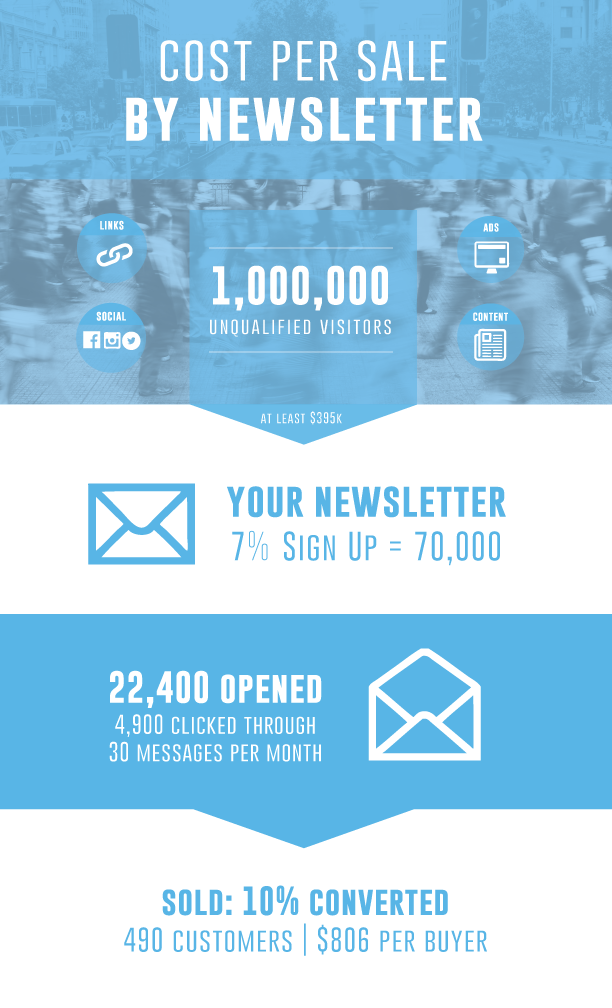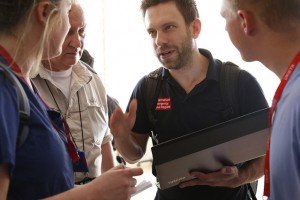 I’m going to say something that might upset a lot of digital marketers.
I’m going to say something that might upset a lot of digital marketers.
Email lists, which are viewed by many digital marketers as sacred, are largely impersonal, and are only as successful as they are because they’re so cheap. According to Hubspot, arguably one of the biggest advocates of inbound marketing, once you go to the trouble of getting people to sign up for your email list, if you send out 16-30 campaigns a month, an enormous amount of work, you can anticipate 32% of the emails being opened, and almost 7% of the emails opened will have a link in them that will get clicked.
Getting subscribers
But how do you get people to sign up for your list (signup conversion)? According to SumoMe, a provider of a pop-up signup solution (yuck), sites using their solution average a 1.76% conversion rate, which is 0.5% better than the next competitor. The top 10% of their users average almost 7% conversion. That means of all the people you get to come to your site, through searching and finding you, social promotion, ads, guest blogging, or any other means, you’ll get at best 7% of those people to signup for your newsletter, and most likely less than 2% will sign up.
Getting inbound traffic
To get that traffic to your site, to subscribe to your newsletter, to get your emails and possibly click on them to go to your site, you’ll need to produce some great content, have it found on search engines, or from promotion on social media, or linked to by trusted sources, or pay to promote it (pay to play) via advertising. Most likely you’ll do a mix of these things to get the kind of traffic you need. Average cost per click (CPC) advertising, such as through Google Adwords, was $1.58 in 2015, with click-through rates of 0.8%. That’s a lot of work and a lot of money. Costs for this will vary depending on how popular your keywords are, and how many people find you organically from search, or from promotion, but it’s not cheap. A nice site, one with good content, that’s search engine optimized, costs money — and that’s not even counting promotion and advertising.
What about sales?
Finally, we get to sales. Remember sales? It’s been a long road to it, so it’s understandable if you don’t remember, and many marketers forget all about sales, as they focus on followers, social media likes, email list signups, and other fun things.
Revenue Per Visitor
So now we move on to Revenue Per Visitor (RPV). That’s how much you make from each person visiting. They are visiting probably for one of these reasons:
- someone told them about you
- they found something you have on your website
- they read about your site on offline material
- they clicked through an ad you ran
- they clicked on some social media you put out there
- they clicked on a link in an email you sent them, likely from a list they subscribed to
Nurturing
If we’re continuing along with our model of people finding your site, signing up for your email list, opening your email, clicking on a link and coming back to the site, now they’re a more qualified lead, since you’ve been nurturing them. That’s distinct from unqualified traffic. Depending on your product or service, people are probably not going to stumble upon your site and make a purchase. They’ll require nurturing.
Conversion rates
Revenue Per Visitor takes into account Conversion Rates (CR) and Average Order Value (AOV) — in other words, how many people did it take to finally make a sale, and how big was the sale? Not the easiest thing to compute for averages across industries. So let’s just focus on Conversion Rates. According to WordStream, which seems to have done a lot of data analysis on this subject, median was 2.35% and top 10% was about 11.5%.
How much traffic from which sources?
There’s no hard and fast rule for how much traffic should come from which source. It depends, as the consultant said. If your company has brand name recognition, you’ll get a high percentage of direct traffic (people just type your url in). When it’s less well known, if you have tons of great content that’s promoted and shared and linked to, you’ll get more from organic search. If no one knows you and you don’t have an encyclopedia of amazing articles that everyone can find, you’re advertising. That gets pricey.
To put the whole process into a step by step process, using the most favorable percentages from what we worked out above:
- You want 1,000,000 unqualified visitors. You use ads to get 25% of them. This is fantastically ambitious, to expect 750,000 visitors based on search,
 social, links and promotion. But let’s make this as ambitious as possible. 25% of 1,000,000 costs $395,000, and with a 7% sign up you’d get 70,000 qualified leads in your email list.
social, links and promotion. But let’s make this as ambitious as possible. 25% of 1,000,000 costs $395,000, and with a 7% sign up you’d get 70,000 qualified leads in your email list. - You send out about 30 emails a month. 22,400 people open their emails and 4,900 click through to a page where they can purchase on your site.
- 10% of those that hit your landing page with the sales oriented call to action are converted, giving you 490 customers. Your Customer Acquisition Cost (CPC), not counting costs for the email system (like MailChimp), your website, ecommerce system or producing all that content for the site and newsletter is about $806. To make a profit, you’ll need to sell them more than that over their lifetime as a customer. These percentages are assuming you are completely rocking the house and better than just about everyone else doing this.
Now take another look at word of mouth stuff, discussed in the last blog post. 13% of sales are from word of mouth. In our little model that we worked out for getting paying customers from email, a 13% increase would be a tiny bit over 63 new customers, which would have cost you over $50,000. But actually, paying customers are worth a lot more. Remember, customers who come to you via word of mouth spend 200% more what average customers spend, and they bring in twice the referrals. Conservatively, that makes those customers worth twice as much. They would have cost $100,000 to get. More money, less cost.
Getting word of mouth referrals
OK, it’s clear we want word of mouth traffic. So how do we get it? What do we need to do? What will it cost?
You’ll still need a website and an ecommerce system. You’ll probably still want to produce content, though perhaps you won’t need as much. What you’ll need to do is listen and help. Doing this in person is ideal — word of mouth in person is always more effective. But assuming you won’t always get to work with people in person, social media is a great resource. And that’s where influence comes in.
Earning your relationships
The typical approach on social media is to write tons of blog posts, make quotes  on images pointing to the blog posts, and post them. Instead of that, search for your audience — your potential customers. Then listen. See what they post and what they ask about. See where the problems are. Then help. Answer their questions. Write blog posts or make videos that help, and share them with the specific people that are having problems, as well as the broader audience. Be helpful. Your discussions will make relationships.
on images pointing to the blog posts, and post them. Instead of that, search for your audience — your potential customers. Then listen. See what they post and what they ask about. See where the problems are. Then help. Answer their questions. Write blog posts or make videos that help, and share them with the specific people that are having problems, as well as the broader audience. Be helpful. Your discussions will make relationships.
Those people you build relationships with will look out for you. [Tweet this]
They’ll refer business to you. They’ll talk about you. They’ll share your content when you ask them. They may even read it without you asking. They’ll invite you to talk on their chats, podcasts and events.
You’ll get more word of mouth if you share great information, great social media posts and great blog posts and videos. All of those can be done without paying for  ads, if your budget doesn’t support it. It may not seem highly strategic, planned out for months to come, with lots of assets developed in advance. It’s not planned out. It’s reactive to your prospective customers needs. Results will likely start out slow, and build over time. You have to go in with reasonable expectations for relationships to grow.
ads, if your budget doesn’t support it. It may not seem highly strategic, planned out for months to come, with lots of assets developed in advance. It’s not planned out. It’s reactive to your prospective customers needs. Results will likely start out slow, and build over time. You have to go in with reasonable expectations for relationships to grow.
That’s word of mouth. It’s personal, it’s intimate, it’s ongoing. Don’t anticipate site crushing traffic, or viral effects. Will you get those? Maybe. But more likely you’ll build up a reputation, an audience and a customer portfolio gradually. You’ll make friends and get work, and learn and you won’t spend a fortune to do it.



